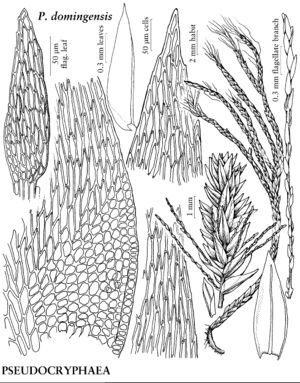Plants usually large, green to golden. Stems creeping, slender, inconspicuous, sympodial, secondary stems ± erect, not or scarcely complanate-foliate; hyalodermis absent, central strand absent; paraphyllia absent; pseudoparaphyllia foliose. Primary stem leaves reduced, scalelike. Branch leaves lanceolate to oblong-ovate, not or slightly concave, not plicate; base sometimes auriculate; margins sometimes limbate from elongate cells; apex gradually short-acuminate; costa single, subpercurrent to excurrent; laminal cells long-hexagonal, walls firm, not or scarcely porose. Specialized asexual reproduction by flagellate branches. [Sexual condition dioicous. Seta short. Capsule immersed to emergent; annulus not differentiated; operculum long-rostrate; peristome single (endostome absent) or double; exostome teeth smooth; endostome basal membrane very low, segments smooth, cilia absent. Calyptra mitrate or cucullate, densely hairy. Spores spheric to irregular, large, smooth to roughened].
Distribution
Fla., West Indies, Central America, South America, e Africa, Indian Ocean Islands, tropical regions.
Discussion
Genera 3, species 6 (1 in the flora).
Rutenbergiaceae are primarily eastern African mosses. The inclusion of Pseudocryphaea in the family is based primarily on molecular data, in part because it is not known in the fertile condition.
Selected References
None.
